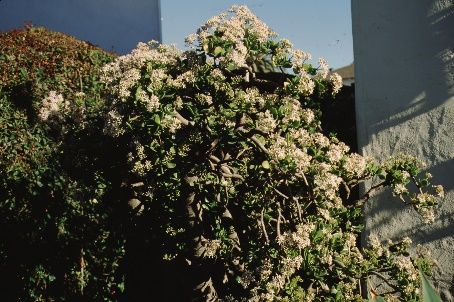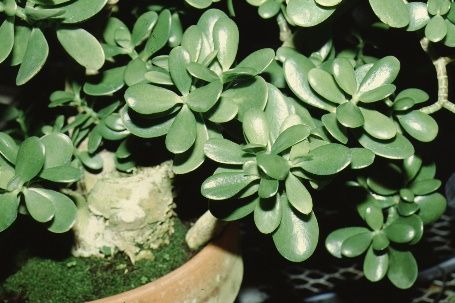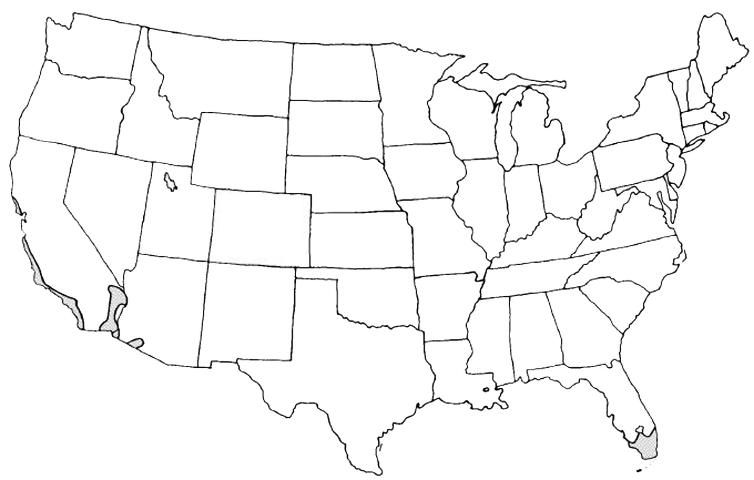Introduction
Jade plants have long been used in containers where they will live for years in root-bound conditions but can also be used as specimen or hedge plantings outdoors in full sun, part sun, or deep shade. While growth is very slow, jade plants are extremely tolerant of poor, dry soil, the thick, succulent leaves, and stout branches acting as water-reservoirs. This characteristic makes them very suitable for houseplants. Install several plants in a container to develop a full plant quickly.

Credit: Edward F. Gilman, UF/IFAS

Credit: Edward F. Gilman, UF/IFAS

Credit: Edward F. Gilman, UF/IFAS
General Information
Scientific name: Crassula argentea
Pronunciation: KRASS-yoo-luh ar-JEN-tee-uh
Common name(s): jade plant
Family: Crassulaceae
Plant type: shrub
USDA hardiness zones: 10 through 11 (Figure 4)
Planting month for zone 10 and 11: year round
Origin: not native to North America
Invasive potential: not known to be invasive
Uses: border; accent
Availability: generally available in many areas within its hardiness range

Credit:
Description
Height: 2 to 4 feet
Spread: 1 to 3 feet
Plant habit: round
Plant density: moderate
Growth rate: slow
Texture: medium
Foliage
Leaf arrangement: opposite/subopposite
Leaf type: simple
Leaf margin: entire
Leaf shape: obovate
Leaf venation: none, or difficult to see
Leaf type and persistence: evergreen
Leaf blade length: 2 to 4 inches
Leaf color: variegated
Fall color: no fall color change
Fall characteristic: not showy
Flower
Flower color: white
Flower characteristic: spring flowering
Fruit
Fruit shape: unknown
Fruit length: less than 1/2 inch
Fruit cover: unknown
Fruit color: red; purple
Fruit characteristic: inconspicuous and not showy
Trunk and Branches
Trunk/bark/branches: showy; typically multi-trunked or clumping stems
Current year stem/twig color: brown
Current year stem/twig thickness: very thick
Culture
Light requirement: plant grows in part shade/part sun; plant grows in the shade
Soil tolerances: sand; acidic; slightly alkaline; loam
Drought tolerance: high
Soil salt tolerances: unknown
Plant spacing: 24 to 36 inches
Other
Roots: usually not a problem
Winter interest: no special winter interest
Outstanding plant: not particularly outstanding
Pest resistance: long-term health usually not affected by pests
Use and Management
Jade plant may grow for many years without blooming. When flowers do appear, they form in small, white or pink clusters at the tips of branches. Blooms are uncommon in the areas of the country with high humidity, such as Florida.
Fast-draining soil is a necessity with jade plant to help avoid root-rot, with waterings being infrequent and only when the soil is very dry. In Florida, too much rain and irrigation prevent this plant from use as a landscape plant in all but the driest soil. It has been used as an outdoor specimen or houseplant in the warm areas of California. Trunks to six inches in diameter can develop on older plants.
There is a cultivar with variegated leaves which is commonly used as a house plant.
Propagation is by cuttings.
Pests and Diseases
Jade plants can be bothered by scale, but their major problem is usually overwatering.
No diseases are of major concern.